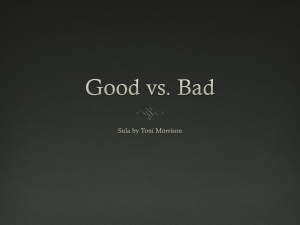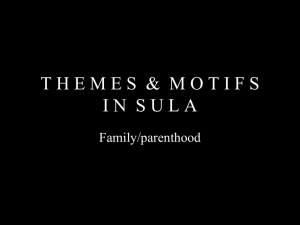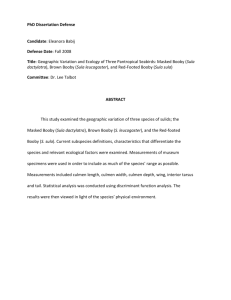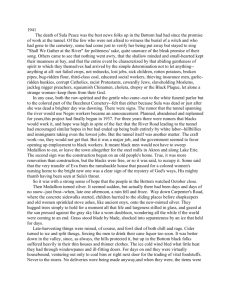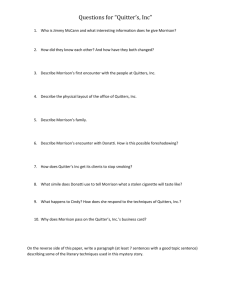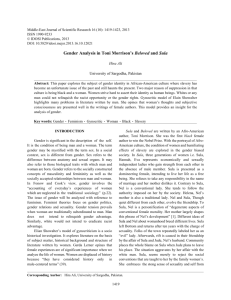Sula by Toni Morrison is a novel, the main theme of which is the
advertisement
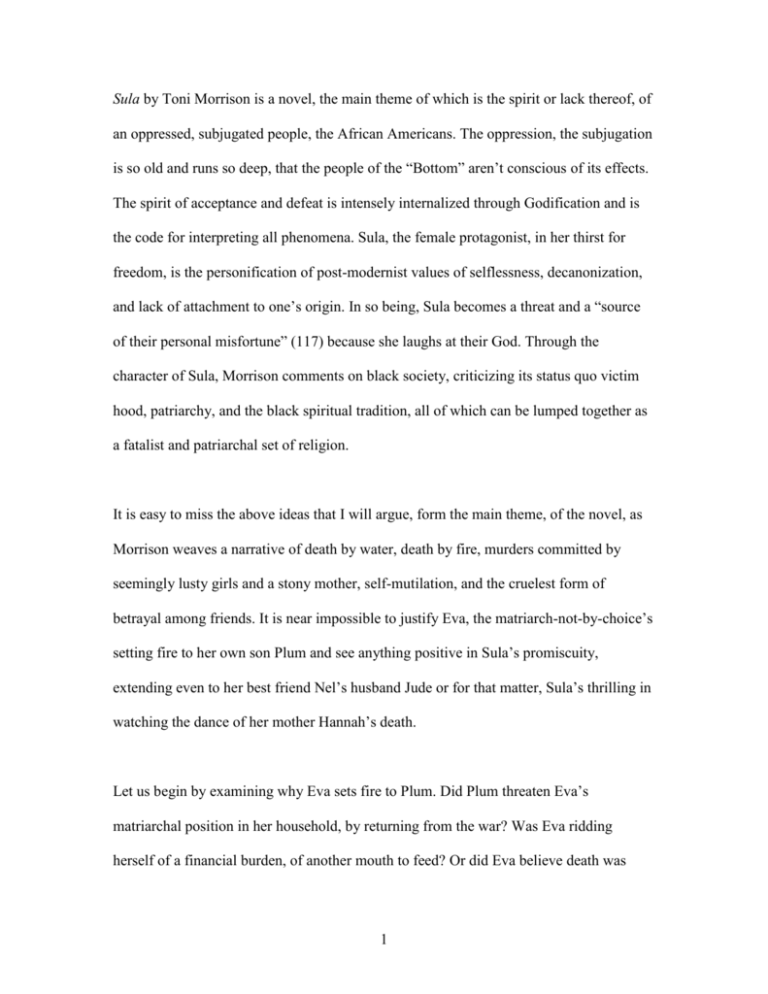
Sula by Toni Morrison is a novel, the main theme of which is the spirit or lack thereof, of an oppressed, subjugated people, the African Americans. The oppression, the subjugation is so old and runs so deep, that the people of the “Bottom” aren’t conscious of its effects. The spirit of acceptance and defeat is intensely internalized through Godification and is the code for interpreting all phenomena. Sula, the female protagonist, in her thirst for freedom, is the personification of post-modernist values of selflessness, decanonization, and lack of attachment to one’s origin. In so being, Sula becomes a threat and a “source of their personal misfortune” (117) because she laughs at their God. Through the character of Sula, Morrison comments on black society, criticizing its status quo victim hood, patriarchy, and the black spiritual tradition, all of which can be lumped together as a fatalist and patriarchal set of religion. It is easy to miss the above ideas that I will argue, form the main theme, of the novel, as Morrison weaves a narrative of death by water, death by fire, murders committed by seemingly lusty girls and a stony mother, self-mutilation, and the cruelest form of betrayal among friends. It is near impossible to justify Eva, the matriarch-not-by-choice’s setting fire to her own son Plum and see anything positive in Sula’s promiscuity, extending even to her best friend Nel’s husband Jude or for that matter, Sula’s thrilling in watching the dance of her mother Hannah’s death. Let us begin by examining why Eva sets fire to Plum. Did Plum threaten Eva’s matriarchal position in her household, by returning from the war? Was Eva ridding herself of a financial burden, of another mouth to feed? Or did Eva believe death was 1 better than the state he was in (clearly his senses were cloudy) and do it to put him out of his misery? Says Eva to her daughter Hannah, of why she killed the child “to whom she hoped to bequeath everything,” (who) “floated in a constant swaddle of love and affection, until 1917 when he went to war,” (45) “It was such a carryin’ on to get him born and to keep him alive. Just to keep his little heart beating and his little old lungs cleared and look like when he came back from that war he wanted to git back in. I birthed him once. I couldn’t do it again.” (71) Here we see that raising her children once was so hard for Eva that she had no capacity left for nurturing anymore. Even if Eva didn’t crush her own leg under a train to support herself and her children by subsisting on health insurance, which may well have happened, Morrison’s words above tell us three things: one, Plum was loved by his mother; two, Eva had a rough time raising him; and three, the experience of war was doing something drastic to African American men (Shadrack being another case in point). So these African American men are going to war, wars in which they don’t know who the enemy is (clearly fighting for the white man), as expressed by Morrison when she says, “…Shadrack had found himself in December, 1917, running with his comrades across a field in France. It was his first encounter with the enemy and he didn’t know whether his company was running toward them or away.” (7) These men from shit, to use Morrison’s own word (in the context of Tar Baby in jail, 133), go fight wars and come back handicapped and burden a crawling society that isn’t even considered legitimate by the white establishment. We know this when the bargeman reports finding Chicken Little’s body to the sheriff at Porter’s Landing and the latter says, “they didn’t have no niggers in the county, but that some lived in those hills ‘cross the 2 river, up above Medallion.” (64) It is a community where sagging businesses drive men to womanizing (49). Furthermore, we read that African Americans bear the brunt of the assimilation process of other peoples that are new to the American soil. Writes Morrison, “In part their place in this world was secured only when they echoed the old residents’ attitude toward blacks.” (53) Are the people of Medallion that fundamentally different from any other set of people? Is there no evidence of humanity that can be found in their midst? To illustrate otherwise, let us recall the Suggs, who bring Eva food “as soon as they found out” about the abandonment by Boy-Boy (32) or Mrs. Jackson who parted with her cow’s milk on a regular basis for Eva’s starving kids. Or the fact that the Suggs take care of Eva’s children for eighteen months as she disappears to find out the way to keep her family alive. Let us also recall that Nel prefers Sula’s house “where a one-legged grandmother named Eva handed you goobers from deep inside her pockets or read you a dream.” (29) And more significantly, the manner in which the same one-legged Eva throws herself out the window to putout the flames on her burning daughter, nearly dying in the process. That the people of the Bottom were capable of the highest emotion is clear from the following passage: “As Reverend Deal moved into his sermon, the hands of the women unfolded like pairs of raven’s wings and flew high above their hats in the air. They did not hear all of what he said; they heard the one word or phrase, or inflection that was for them the connection between the event and themselves. For some it was the term “Sweet Jesus.” And they saw the Lamb’s eye and the truly innocent victim: themselves. They acknowledged the innocent child hiding in the corner of their hearts, holding a sugar-and-butter sandwich. That one. The one who lodged deep within their fat, thin, old, young skin and was the one the world had hurt. Or they thought of their son newly killed and remembered his legs in short pants and wondered where the bullet went in. Or they remembered how dirty the room looked when their father left home and wondered if that is they way the slim 3 young Jew felt, he who for them was both son and lover and in whose downy face they could see the sugar-and-butter sandwiches and feel the oldest and most devastating pain there is: not the pain of childhood, but the remembrance of it.” (65) And here follows the spirituality of acceptance that Morrison criticizes: “…they danced and screamed, not to protest God’s will but to acknowledge it and confirm once more their conviction that the only way to avoid the Hand of God is to get in it.” (65) Spews Morrison, of the spiritual beliefs of the people of Medallion: “The purpose of evil was to survive it and they determined (without ever knowing they had made up their minds to do it) to survive floods, white people, tuberculosis, famine and ignorance.” (90) Sula, the adult’s entrance into the novel is marked by robins that are “flying and dying all around,” (89) interrupting the humdrum of life in the Medallion, a life marked by the stunted dreams of its inhabitants. Sula’s is an “experimental life” and she has acquired the two important lessons (postmodernist values): lack of concern and attachment to your origin, “ever since her mother’s remarks sent her flying up those stairs;” and selflessness, “ever since her one major feeling of responsibility had been exorcised on the bank of a river with a closed place in the middle” that made her realize “that there was no self to count on.” (119) At this point in the novel, we see Morrison speak comment through Sula directly, when she says, “Now Nel was one of them. One of the spiders whose only thought was the next rung of the web, who dangled in dark dry places suspended by their own spittle, more terrified by the free fall than the snake’s breath below. If they were touched by the snake’s breath, however fatal, they were merely victims and knew how to behave in that role (just as Nel knew how to behave as the wronged wife).” (120) Patriarchy is another institution that Morrison criticizes through several characters in novel. The “trinity” of deweys, who love “nothing and no one but themselves” (38) and maintain an “annoying privacy,” and whom everyone confuses are Morrison’s symbol of 4 universal patriarchy and remain “a mystery not only during all of their lives in Medallion but after as well.” The Peace women, in all their “man-love,” become progressively more irreverent of the patriarch, Eva standing for the male-female conflict, Hannah for mere physical need, and Sula using her exchanges with men for the purpose of selfexploration. The only man that we see Sula get emotionally interested in, is Ajax, who idea of bliss is to keep his head above dangerously scalding water, which sums up his own character in the novel. Ajax is a dreamer, who nonetheless, is completely comfortable in the status quo. Sula, on the other hand, chooses to be a pariah (122), reveling in her insubordination, finding comfort only in the “utmost irony and outrage in lying under someone, in a position of surrender, feeling her own abiding strength and limitless power.” (123) Building on the theme, Shadrack and Sula become two opposing but equally important characters in the novel. The former being male, marked by fear of change (“always”), creator of ritual and the latter being female, suffocating in permanence, flouting and challenging tradition. Says Morrison, of Sula, “like any artist with no art form, she became dangerous.” (121) That Sula’s theme is the dysfunctionality of existing spiritual order comes in focus, as Sula’s death is marked by “that same gentleness of spirit” that stemmed from the “determination not to let anything – anything at all: not failed crops, not rednecks, lost jobs sick children, rotten potatoes, broken pipes, bug-ridden flour, third-class coal, educated social workers, thieving insurance men, garlic-ridden hunkies, corrupt Catholics, racist Protestants, cowardly Jews, slaveholding Moslems, jackleg nigger preachers, squeamish Chinamen, cholera, dropsy, or the Black Plague, let alone a strange woman – keep them from their God.” (150) 5
